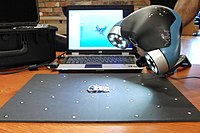
Photo from wikipedia
This paper presents a comparative analysis of the ability to recognize three mirror forms in visual and acoustic tasks: inversion (reflection on a horizontal axis), retrograde (reflection on a vertical… Click to show full abstract
This paper presents a comparative analysis of the ability to recognize three mirror forms in visual and acoustic tasks: inversion (reflection on a horizontal axis), retrograde (reflection on a vertical axis) and retrograde inversion (reflection on both horizontal and vertical axes). Dynamic patterns consisting of five tones in succession in the acoustic condition and five square dots in succession in the visual condition were presented to 180 non‐musically expert participants. In a yes/no task, they were asked to ascertain whether a comparison stimulus represented the “target” transformation (i.e., inversion, retrograde or retrograde inversion). Three main results emerged. Firstly, the fact that symmetry pertaining to a vertical axis is the most easily perceived does not only apply to static visual configurations (as found in previous literature) but also applies to dynamic visual configurations and acoustic stimuli where it is in fact even more marked. Secondly, however, differences emerged between the facility with which the three mirror forms were recognized in the acoustic and visual tasks. Thirdly, when the five elements in the stimulus were not of the same duration and therefore a rhythmic structure emerged, performance improved not only in the acoustic but also (even more significantly) in the visual task.
Journal Title: Symmetry
Year Published: 2017
Link to full text (if available)
Share on Social Media: Sign Up to like & get
recommendations!